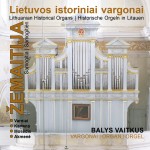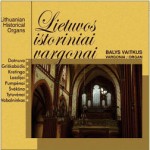Lithuanian history of organs started 600 years ago. The first archival testimony about organs in Lithuania was dated 11th April 1408, when the Grand Master of the German Order Ulrich von Jungingen from Marienburg sent a present – a clavichord and a portative organ – to Anna, the wife of Vytautas, Grand Duke of Lithuania (item 6 m. vor eyn Clavicordium und Portativum, das unsers Homeysters Herzoge Wytowten Frauwe santé).
At present there are about 450 authentic organs surviving in Lithuania. About 250 of them are included in the register of Lithuanian valuable cultural objects. They were built in the 18th–20th centuries and represent the style of baroque, classicism and romanticism in organ building. Probably the oldest surviving object is the portative organ dating back to the end of the 17th century in the church in Akmuo village (Varėna district). Its remains were found in the loft of the church. They were collected together and are now exhibited at the Lithuanian Museum of Theatre, Music and Cinema in Vilnius.
The Vilnius Late Baroque Organ Building School dated from the second half of the 18th to the first half of the 19th century played an important role in the history of Lithuanian organs. The heritage of its representatives– organ builders – holds an important place in the history of the art of organ building in Lithuania, Belarus, Latvia and Poland. The organs of the school that functioned for about a century were distinguished by original late baroque features and a stylistic conversion from baroque-style instruments (a combination of a baroque instrument and baroque facade) to a combination of baroque instrument and classicist facade. This stylistic fusion of baroque and classicism appeared at the end of the 18th century when rococo and classicist applied art tendencies appeared in facade ornamentation and form, while the musical part did not change much stylistically: late baroque stop lists remained in organs until the middle of the 19th century.
For a long time the stylistically unique organ building school of our country was analysed inseparably from the heritage of the Königsberg organ masters as a marginal expression of the region on the territory of our country. This point of view must have been formed by the fact that the sources of the Vilnius organ building school were the activities of the masters who arrived in the Grand Duchy of Lithuania from Germany and East Prussia in the middle of the 18th century and brought the organ building traditions of these countries. Analysing historical organs in our country, the issue of authorship has to be addressed as at that time in Lithuania the trade of the organ builder was not exceptional (like other spheres of applied art), unlike in neighbouring Eastern Prussia, the Courland or Livonia with Lutheranism prevailing, where more attention was paid to the individuality of the organ builder. Archival data about the organ masters who built instruments in the churches of the Grand Duchy of Lithuania between the 17th and 19th centuries is scarce and scattered with church documents showing mostly the names of the donors or those who commissioned them, while the masters’ names are not even mentioned.
Thorough research into the heritage of the organ in our country demonstrates that in Lithuania at that time stylistically autonomous tendencies of organ construction were highlighted and evolved into a unique tradition of organ-making craft – that is, into the phenomenon of the century school that united a considerable number of organ builders, their journeymen and followers. While referring to the organ itself the striking features of sound, decoration and double-tower architecture of the organ façade were established.
Dr. Girėnas Povilionis
| AUDIO: CDS Lithuanian Historical Organs, released in 2008, 2015 | ||||
|---|---|---|---|---|
News
 |
2015-12-03
In December 2015, Centre for Lithuanian Organ Heritage released the 2nd CD Lithuanian Historical Organs. Samogitia with the record of organs in four Samogitian churches (Varniai, Kartena, Mosėdis, Akmenė). See: Lithuanian Historical Organs. Samogitia, 2015, VPC 002. |
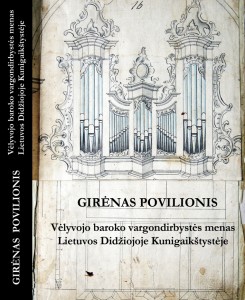 |
2015-05-10
Centre for Lithuanian Organ Heritage published a monograph by Girėnas Povilionis The Late Baroque Organ Building Art in the Grand Duchy of Lithuania (Vilnius, 2013, 384 p., ISBN 978-609-95485-0-0). See: Monograph The Late Baroque Organ Building Art in the Grand Duchy of Lithuania, 2013. |
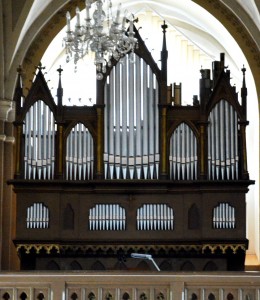 |
2015-01-10
In 2014, dr. Girėnas Povilionis and Bernard Termen restored the historical organ by Bruno Goebel (1935) at Akmenė St. Anne’s church. |
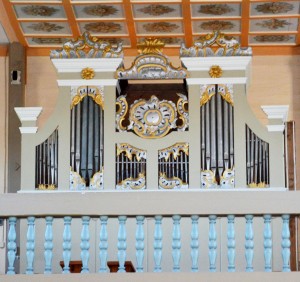 |
2010-03-01
In 2009, dr. Girėnas Povilionis and organ masters Algis Stepanauskas & Gintautas Pilypaitis from Marijampolė restored the organ at Kartena St. Mary of the Assumption Church. |



